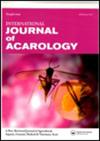Acaricidal effects of Tagetes minuta L. (Asteraceae) against Tetranychus truncatus Ehara (Prostigmata: Tetranychidae)
IF 1
3区 农林科学
Q3 ENTOMOLOGY
引用次数: 0
Abstract
ABSTRACT The study evaluated the efficacy of solvent fractions of Mexican marigold, Tagetes minuta against the spider mite, Tetranychus truncatus. The dried and pulverized botanical was subjected to sequential extraction using three solvents viz., hexane, chloroform and water in the increasing order of polarity. Solvent fractions were evaluated for their ovicidal and adulticidal activities against T. truncatus in the laboratory at five different concentrations viz., 0.025, 0.05, 0.1, 0.15 and 0.2 %. Results indicated that only hexane fraction at higher concentrations of 0.15 and 2.0 % exhibited significant ovicidal action, causing 100.00 and 81.33 per cent egg mortality, respectively. However, all the fractions recorded significant adulticidal effect at higher concentrations with hexane fractions at 0.2 and 0.15 % recording significantly higher adult mortality (>90 %), followed by chloroform fraction. The best concentrations of the three solvent fractions identified in the laboratory study were evaluated against T. truncatus on amaranthus, in a pot culture experiment. Fourteen days post treatment, hexane fraction at 0.2 % reduced mite population by 88.78 per cent and was superior to neem oil emulsion at 2% (76.44 % reduction), which was on par with chloroform and aqueous fractions. Results of the study identified Mexican marigold as a potential candidate in mite pest management, which may be further validated through multi-locational field trials.微小Tagetes minuta L.(菊科)对截断叶螨的杀螨作用
摘要本研究评价了墨西哥万寿菊的溶剂组分对截叶螨的防治效果。使用三种溶剂,即己烷、氯仿和水,按照极性的增加顺序对干燥和粉碎的植物进行连续提取。在实验室中,在0.025、0.05、0.1、0.15和0.2%的五种不同浓度下,对溶剂组分的杀卵和杀伪活性进行了评估。结果表明,只有浓度较高(0.15%和2.0%)的己烷部分表现出显著的杀卵作用,分别导致100.00%和81.33%的卵子死亡。然而,所有组分在更高浓度下都记录了显著的诱杀效果,己烷组分在0.2%和0.15%时记录了显著更高的成人死亡率(>90%),其次是氯仿组分。在盆栽实验中,对实验室研究中确定的三种溶剂组分的最佳浓度进行了评估,以对抗在苋上的截断T.truncatus。处理后14天,0.2%的己烷组分使螨的数量减少了88.78%,优于2%的印楝油乳液(减少76.44%),后者与氯仿和水性组分相当。研究结果表明,墨西哥万寿菊是螨类害虫管理的潜在候选者,这一点可以通过多地点实地试验得到进一步验证。
本文章由计算机程序翻译,如有差异,请以英文原文为准。
求助全文
约1分钟内获得全文
求助全文
来源期刊
CiteScore
2.20
自引率
9.10%
发文量
60
审稿时长
6-12 weeks
期刊介绍:
The International Journal of Acarology has a global readership and publishes original research and review papers on a wide variety of acarological subjects including:
• mite and tick behavior
• biochemistry
• biology
• control
• ecology
• evolution
• morphology
• physiology
• systematics
• taxonomy (single species descriptions are discouraged unless accompanied by additional new information on ecology, biology, systematics, etc.)
All submitted manuscripts are subject to initial appraisal by the Editor. If the English is not of a quality suitable for reviewers, the manuscript will be returned. If found suitable for further consideration, it will be submitted to peer review by independent, anonymous expert referees. All peer review is single blind.

 求助内容:
求助内容: 应助结果提醒方式:
应助结果提醒方式:


